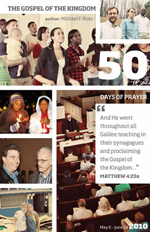By Zachary Bradley
Editor’s Note: Zach Bradley has been the Assistant Pastor and Director of Student Ministries at Evergreen Presbyterian Church in Sevierville, TN for 5 years. Zach is originally from Virginia Beach, VA and went to Wake Forest University and Gordon-Conwell Theological Seminary. Zach has a passion for relational and mercy ministry, gardening, and the ocean.
For decades now churches of all stripes have re-organized their ministries around small groups. Many new churches organize their churches around the growing and splitting of small groups until the corporate whole becomes large enough to gather for a larger worship service. As they grow, many of these churches maintain a philosophy of ministry rooted in small groups. Similarly, many established churches have shifted the primary means of ministry to small groups. While not eschewing other ministries, the hub of the wheel from which ministry goes forth has moved from the Sunday morning gathering to the small group, which has become the primary place for fellowship, discipleship, evangelism, and/or service.
The one place where this fundamental shift has not taken root is in youth ministry. While most youth groups have a small group program of some kind (usually exclusively or nearly exclusively for the purpose of discipleship), most have not fundamentally restructured the ministry so that small groups, rather than a large group gathering are the primary means for ministry. I would like to suggest that many student ministries can find increased efficiency, spiritual and numerical growth, and ultimately more impact for the Kingdom of God by shifting away from the large group as the primary means for ministry and recasting small groups as the primary means for ministry.
Large Group Centered Student Ministry
The flagship program of most student ministries is the large group corporate gathering, a model that has largely held in youth ministry since its beginning. This meeting traditionally is a time for students to gather together, engage in games, sing Christian (or secular) songs, and listen to teaching. The meeting typically functions as the focal point of outreach, as it is a place to which students and leaders can invite non-Christian friends. One advantage of the large group is that it enables one youth pastor to speak directly to a large number of students. However, there are a number of drawbacks to the large corporate group as the central focus of youth ministry, three of which will be discussed here. Your ministry may have none, some, or all of the following problems.
1) It is Difficult to Judge the Effectiveness of the Message
A corporate setting provides the opportunity to share the same message with many students at once, but while this approach is efficient, it can be ineffective in producing spiritual growth. Students’ attentiveness may also be lessened in a large group setting. It is easier for students to zone out in a large group setting, even when it looks like many may be paying attention. Also, students in a large group likely range in spiritual maturity from one end of the spectrum to the other. While a challenging talk on deep theological truths may greatly influence one student, it may leave several utterly confused. A simple presentation of the gospel may enlighten several students to the work of Christ on our behalf, but more mature students may be left wanting something more. Some students may grasp a truth that is being taught intellectually but not be given the chance to chew on it and digest it. She may understand the message, but unless she has a chance to wrestle with it a little, it may not set up shop in her hearts. Many students listen intently, but forget what was said as soon as they walk out the door.
Additionally, it is difficult for leadership to gauge whether or not a message at a large group meeting is effective. Even if all the above contingencies were false and most students were paying attention, understood the message, and applied it, most youth pastors would not know it. Unless a youth pastor or leader takes the time each week to debrief with each student, nobody would know if he listened to, understood, and appropriated the message. Such an approach would require a tedious amount of work and an inordinate amount of time and intentionality. There is not enough time or human resources to have so many one-on-one discussions with students after the youth night. As a result, for many youth pastors the default indicator for knowing if messages have impacts on students’ lives becomes the number of students dedicating or rededicating their lives to Christ. While this is an important indicator of spiritual growth, it is by no means the only one. In any event, it is useless in judging whether or not students were able to digest any message that was not solely evangelistic.
2) First-time Visitors Can Easily Slip Through the Cracks
In a large group setting, it is not difficult for a newcomer to go unnoticed. Unless there is a particularly effective strategy for volunteers meeting new students, it is easy for students to blend in and avoid contact. Try as they may, adult leaders may not get around to meeting new people in the often short time before the program starts or before new students head for the exits at the end of the night. This is especially true if there is a particularly large influx of visitors on one particular night. One visitor may be greeted by several leaders while another is greeted by none. Despite their best intentions, only the best leaders are adept at learning new names and remembering them. Difficulty remembering names is compounded if a new student visits one week, skips the next week, then comes again, with no other contact between her and a leader.
The youth pastor is usually the person best equipped to know who is visiting and who has come, even once before. However, on a large group program-driven night, he is frequently rushing to make sure everything is in place and ready, taking him away from the valuable opportunity to engage, assimilate, and have significant conversations with visitors. Because a large group meeting is not conducive to building substantial relationships, it creates an environment in which it is easy for visitors to slip through the cracks.
3) Youth Worship Becomes a Substitute for Church-wide Corporate Worship
Many churches have already instituted a separate youth worship service on Sunday mornings to take the place of the adult corporate worship. This practice is hard to reconcile with the picture the New Testament gives us of a diverse church that cuts across social boundaries (Ephesians 2:11-22). It also seems to further feed the current problem of students graduating from church when they graduate from high school. Many students find it difficult to assimilate into a church that is unlike their youth service upon graduation. The attachment to the youth service is not limited to the ones occurring concurrently with the church’s worship service. The large group centered youth ministry can essentially become a substitute for Sunday worship, even when it occurs on another night of the week. It looks similar. It happens at church. Many students count their participation at church youth group as their church for the week. Youth pastors are often more concerned with getting students to youth group than to church itself; most are quick to invite students to the youth service, but few place high priority on inviting students to the corporate worship service. However, nothing in Scripture calls us to segregate worship experiences, and doing so seems to be counterproductive to long-term spiritual health. As Mark DeVries writes, “Teenagers’ involvement in the worship of the church yields more significant long-term results than does even the most active involvement in the youth program or Sunday School.”[1] Yet we have seen fit to create a separate, albeit less effective church-within-a-church for adolescents. This youth-group-for-church substitution is partly why “contemporary churches have often been much more effective in providing young people with meaningful connections to the orphaning structure of the youth group than to the lifelong structure of the church.”[2]
Small Group Based Youth Ministry
It takes a fundamental shift in philosophy to re-structure youth ministry with small groups as the primary method of ministry. While this could be a difficult transition, it can also greatly increase effectiveness and efficiency in ministry and address some of the problems mentioned above. Some of the reasons for transitioning to small groups as the primary means of ministry could include the following.
1) Greater Effectiveness in Teaching through More Personalized Attention and Ministry
Because each leader knows her students better than any other leader (including the youth pastor), she is the most knowledgeable about what they ought to be discovering in Scripture and learning in their time together. She can then tailor her lessons to her specific group in a way that is at least somewhat more specific than the entire group hearing the same talk. If her students are completely clueless about the gospel, she can discuss the basic truths of the faith. If her students are mature Christians, she can teach accordingly. Even if students are at different spiritual levels, a good lesson can both share the gospel with those who do not know it and challenge the committed. The difference is that because the group is smaller and (hopefully) more interactive, students are less able to disengage and forced to interact more with the material. This increases the chances that they will comprehend the material rather than merely hear it. If something is unclear, a good leader can stop the lesson and explain.
A small group also has great value in that it models a personal relationship with God to students. It does this in two ways. First, time in a small group can encourage personal devotional time by mirroring a quiet time or devotional. Many students are hesitant to engage in devotional time or prayer because they do not know how. In a small group, however, they are practicing a devotional time with God at least once a week, praying, reading Scripture, engaging in inductive bible study, and praying again. This breaks down confusion and frustration in introducing students to personal devotional time. Second, a small group leader can more effectively teach students how to pray, both by encouraging them to pray for each other, but also by modeling rich, robust prayer. This also has the added benefit of students being able to hear their leader spiritually care for them through specific personal prayer.
2) Greater Effectiveness in Retention through Deeper Relationships
In a small group based youth ministry it is extremely difficult for visitors to slip through the cracks because every visitor necessarily engages in a relationship with a specific adult. As newcomers come to the group and are split off into small groups with other leaders, each visitor is necessarily assigned to one particular adult who is responsible for follow up. At one time this eliminates the inconsistency of ministry toward one particular student, ensures that each new student will be greeted, and sets into place a natural and systematic strategy of follow-up.
Also, a small group that sets apart a significant amount of time for sharing ensures that the beginning of a strong relationship is built between the leader and the student (and the other students). The leader then knows much more about the student than through a superficial conversation that is completed in 2 minutes before the youth program. Leaders remember students much more easily if they have heard about their lives, and there is a stronger foundation for relationship in a follow-up phone call or text message.
Students who are given the opportunity to share their lives have a better understanding that they are loved than those who are merely talked at for 30 minutes. Students desire to be known and accepted, especially by adults. As DeVries says, “The most important priority a church can have in its work with teenagers is providing them with opportunities for significant dialogue and relationships with mature Christian adults.”[3] A small group based youth ministry makes sure this happens with all students in a youth ministry, not just the ones with the time, resources, and inclination to seek it out on their own.
3) Greater Efficiency in Ministry through Streamlining
It has long been the unstated rule that a good large group program is essential to outreach youth ministries, and youth ministries in general. However, a simple cost-benefit analysis shows that the time we spend on programs are probably not the most efficient way to do ministry. While some estimate that youth pastors spend 90% of their time on preparing the week’s program, only 21% of students say that a “fast-paced, high-tech, entertaining ministry approach” is important to them, the lowest rate of any other factor.[4] Many of us feel tremendous pressure to put on a cutting-edge, state-of-the-art weekly program, but this extraordinary amount of time, effort, and resources may have a disproportionate ministry effect. Some students, particularly those already in the church, may be willing to attend a few different functions per week. But the vast majority of those who are unchurched are available once per week. If I know I have 1.5 hours a week with a student, I would much rather sit down and talk with him and have him talk at length about his life and Jesus than have him play several games and sit through a message he may not appropriate.
[1] Mark DeVries, Family-Based Youth Ministry (Downers Grove, IL; InterVarsity Press, 2004), 198.
[2] Ibid, 88.
[3] Ibid, 56.
[4] Mark DeVries, Sustainable Youth Ministry (Downers Grove, InterVarsity Press: 2008), 164, 161.


